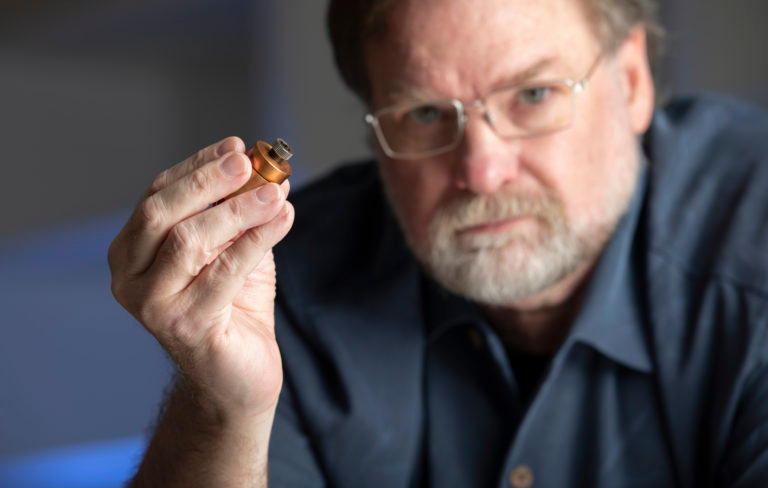May 20 2020
The home entertainment console found in almost all houses could be the key to a new weapon in the battle against the coronavirus.
 Chris Barty, UCI Distinguished Professor of physics & astronomy, is leading a team working to develop a way to halve the wavelength of photons emitted by Blu-ray diodes—which is around 405 nm—to the germicidal UV-C band, which poses minimal risk to humans. Image Credit: Steve Zylius/UCI.
Chris Barty, UCI Distinguished Professor of physics & astronomy, is leading a team working to develop a way to halve the wavelength of photons emitted by Blu-ray diodes—which is around 405 nm—to the germicidal UV-C band, which poses minimal risk to humans. Image Credit: Steve Zylius/UCI.
Led by physicist Chris Barty of the University of California, Irvine (UCI), a research team has been investigating the use of diodes from Blu-ray digital video disk devices as sources for deep-ultraviolet (UV) laser photons to quickly disinfect not just surfaces but also the indoor air around people.
According to Barty, who is a Distinguished Professor of physics and astronomy at UCI, such UV light sterilizers would be inexpensive when compared to existing medical- and scientific-grade systems and it would be possible to use them almost anywhere.
If these sources are successful, I think you could build them into a mask and clean the air that’s coming in and out of you. Or you could set these things up in the air circulation ducts of major buildings, and the airflow that goes through could be sterilized.
Chris Barty, Distinguished Professor of Physics and Astronomy, University of California, Irvine
In addition, they could be integrated into hand-held wand devices, stated Barty, or as a “light curtain” through which people enter a room, where they are exposed to UV-C radiation. He added that at a wavelength of 200 to 260 nm, the UV radiation will kill viruses and other pathogens with only minimal risk to humans.
“There is evidence to suggest that the UV-C band is actually not an issue for us, especially at the shorter wavelengths, because it gets absorbed by dead skin cells or by a teardrop on your eye,” noted Barty, who is also the head of UCI’s Convergent Optical Sciences Initiative.
Hospitals use UV-emitting robots that are about the size of a dorm room refrigerator. They just wheel them in and plug them into the wall to sterilize the place, but everybody has to leave because in addition to UV-C, they make a lot of UV-A and UV-B, which can cause harm to humans.
Chris Barty, Distinguished Professor of Physics and Astronomy, University of California, Irvine
Such roaming hospital sterilizers—based on high-current mercury discharge lamps—are too expensive to be deployed at the scale required to combat the coronavirus, which exists everywhere from meatpacking plants to cruise ships. Barty noted that Blu-ray diode lasers provide a promising way to a compact, affordable solution, as the technology is versatile and costs only tens of dollars per unit.
Barty and his colleagues have been working to devise a technique to halve the wavelength of photons discharged by Blu-ray diodes—which is about 405 nm—to the germicidal UV-C band.
This is really more of an applied physics versus a pure physics view of the world. The issue is not whether you can make UV-C light. It’s whether you can fundamentally reduce the dollar-per-watt output of a device to a place that it becomes compelling to use UV-C light.
Chris Barty, Distinguished Professor of Physics and Astronomy, University of California, Irvine
Barty said Blu-ray sterilizers could be produced in the “same kind of quantities as you can make other telecommunications components, so you could really change the game.”
Commenting over the current scenario, where meticulous efforts are being taken to develop vaccines to prevent COVID-19 infections and drugs for the treatment of people affected by the virus, Barty noted, “I would prefer that we just destroy it.”